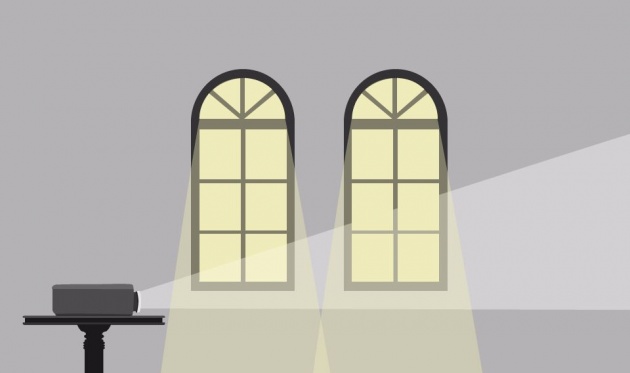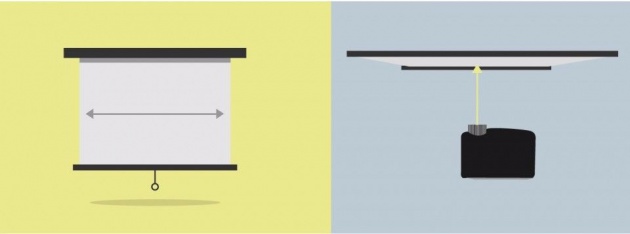What is a projector?
A projector might be best considered as an altered camera, spitting light out of a lens instead of accepting it. For the purpose of this purchasing guide, we will be considering advanced projectors—that is, projectors with video inputs that serve a comparable capacity to a TV or PC screen while offering various advantages, including the capacity to deliver much bigger picture sizes and simple versatility. The standards I will diagram underneath apply to a wide range of projectors. Be that as it may, it will begin by isolating computerized projectors into four classes:
Pocket, likewise called "pico"
Home theater
Interactive media
Expansive venue and altered establishment (a subset of interactive media)
Clearly there will be cover, and not all models will fit effectively into a specific class. For instance, home theater and interactive media projectors are fundamentally the same. Much of the time, it will be clear from your application which sort you require. Meeting room presentations: this will be media. In a front room: home theater. For an address lobby, seating 500 individuals: expansive venue. Ultra-compact, where a little screen size is worthy: pocket or pico projecto

Pocket projectors are still a moderately new innovation. Albeit most would require a genuinely vast pocket, they are sufficiently little to grasp, and as a rule can be mounted on a tabletop tripod also. Since they utilize LED lights, they aren't brilliant: 20 to 1,000 lumens. In correlation, interactive media projectors ordinarily extend from 2,500 to 4,500 lumens (higher on the off chance that we included settled establishment). This makes them valuable as a different option for conveying a screen or TV around, however they won't generally cut it if you will likely present to a gathering of more than a couple individuals. As of not long ago, take projectors have been viewed as to a greater extent an oddity—a fun buyer thing—than a genuine presentation innovation. Be that as it may, as LED lights enhanced, the capacities of pico projectors have expanded and they are beginning to infringe upon the convenient fragment of the mixed media projector market.
Another outstanding restriction normal to stash projectors is the absence of a zoom lens. This implies the main way you can control picture size is by physically drawing the projector nearer or more distant far from the screen. In the event that you support conservative structure variable over brilliance and zoom, a pico might be a good fit for you. If not, you are most likely a possibility for a sight and sound projector.
Interactive media projec

Interactive media projectors speak to the biggest class, and are the most broadly sold at B&H (near 800 models, at present). Interactive media projectors are universally useful, and are utilized for everything from giving PowerPoint presentations to screening video cuts and slideshows at weddings. They are commonly viewed as convenient, weighing from 3 pounds for the ultra-thin models and going up from that point, and their brilliance ranges from 2,500 to 4,500 lumens or somewhere in the vicinity. Aside from the extraordinary sub-classification of short-toss, they essentially dependably have zoom lenses. Notwithstanding, the zoom reach is normally shorter than that of their home theater partners: 1.2x to 1.5x (contrasted with 2x in the home-theater domain). This implies unique care should be taken when picking, to ensure the screen size is good with the projector's toss proportion. Mixed media projectors for all intents and purposes dependably have VGA and composite video inputs, and most models now include HDMI also. Now and again, a DVI-D port will be given rather than HDMI, however a HDMI gadget can in any case be joined utilizing a reasonable connector. So also, DVI gadgets can be associated with a projector with just HDMI utilizing a DVI to HDMI link or connector.
Regular resolutions for sight and sound projectors are SVGA (800 x 600), XGA (1024 x 768), WXGA (1280 x 800), and WUXGA (1920 x 1200), however 4K is directly into the great beyond. The most prevalent determination is XGA, and is by and large suitable for PowerPoint presentations—in any case, since it is a 4:3 organization, may not be perfect in the event that you plan to screen top quality.

Short toss projectors
"They are commonly divider as opposed to roof mounted, and are intended to be introduced near the screen: 18 inches to 2 feet."
Albeit most sight and sound projectors have an inherent zoom lens, an essential subcategory is short toss and ultra-short toss. By and large, a toss proportion of under 1:1 is viewed as short toss. The most well-known toss proportions are 0.5:1 and 0.3:1, with the last satisfying the qualification of being "ultra-short toss." Short toss projectors never have zoom lenses, and as a rule they utilize a mirror onto which the picture is anticipated initially, before being reflected at the screen. They are regularly divider as opposed to roof mounted, and are intended to be introduced near the screen: 18 inches to 2 feet. Short toss projectors are frequently utilized as a part of classrooms, and are perfect for blending with computerized whiteboards. One may be enticed to put a short toss projector further back than the suggested couple of feet, as an approach to accomplish a vast picture in a little space (expecting adequately low encompassing light levels, obviously). This presumably won't work, since short toss projectors cornerstone extremely when utilized outside their prescribe toss separation go, and will require some exceptionally imaginative mounting to deliver an undistorted picture. Since they are implied for littler screen sizes (8 feet wide or less), short toss projectors regularly best out at 3,000 lumens. On the off chance that you require a brighter projector and have restricted space, you should take a gander at an altered establishment projector with interchangeable lenses instead.

Genuine home theater projectors—instead of media/home theater hybrids, which from a component point of view can be dealt with as interactive media projectors—put the accentuation on picture quality most importantly else. They once in a while get brighter than 2,500 lumens (however this is by all accounts changing), and have the most zoom of any projector sort that uses worked in lenses. They are expected for use in a lounge room, or maybe little screening room, where the encompassing light can be controlled totally. They utilize either DLP or LCoS imaging innovation, never three LCD, and will for the most part give you the most attractive photo of numerous kinds, accepting you utilize them in complete dimness and at a sensible toss separation.
Home theater projectors regularly highlight low-voltage control (LVC), so that killing the projector on or can trigger the screen to rise or slip, or open and close on the off chance that it is an altered edge secured by window hangings. To accomplish the calmest conceivable operation, they have more proficient—or more involved—cooling frameworks, making them moderately massive and, now and again, not able to bolster rearranged establishment. They are likewise the most costly sort of projector, with respect to details. Essentially all are Full HD or 4K (genuine DCI 4096 x 2160 4K, truth be told). Be watchful, however. Organizations frequently knot what are basically restyled interactive media projectors into the home theater classification. Indications are high lumen evaluations (more than 3,000 lumens), VESA instead of HD video local resolutions, (for example, WXGA and WUXGA), and zoom that is shorter than 2x.
On the off chance that you need an incredible picture, can shut out all surrounding light, and are working with a screen size of up to 100 inches or somewhere in the vicinity, home theater projectors are an awesome decision. Else, you might need to consider a brighter interactive media projector, regardless of the fact that you plan to utilize it in a home theater setting.
Altered establishment
Altered establishment and expansive venue projectors are frequently included together with interactive media projectors. They are the brightest sort accessible in the purchaser market, beginning at around 4,500 lumens and going up to 20,000 or more. Establishment projectors are not for the most part thought to be versatile, and require some investment to set up. Much of the time, they include exchangeable lens frameworks, making them the most versatile regarding toss separation. They are regularly utilized as a part of address lobbies, motion picture theaters, places of love, stadiums, and other comparable settings that require screening for huge gatherings. Notwithstanding huge screen sizes, they are utilized as a part of settings where surrounding light can't be controlled. Numerous likewise bolster stacking, which means the yield from two or more projectors can be amassed to build the splendor past what a solitary projector can accomplish.

In view of their weight and the way of the lens frameworks they use, much of the time, establishment projectors ought to be specced out by an integrator, and require establishment by an expert.
Presently we come to executing the three bits of data specified before.




